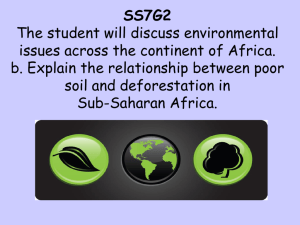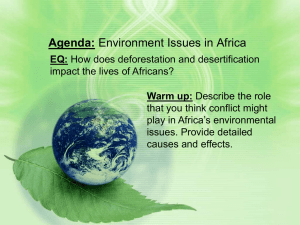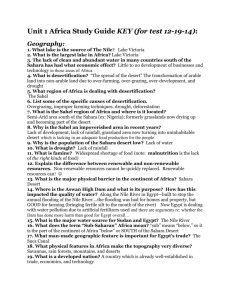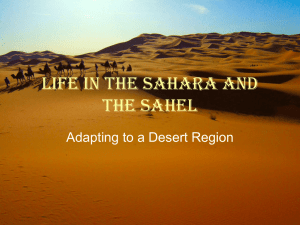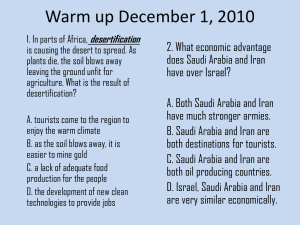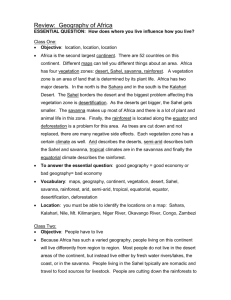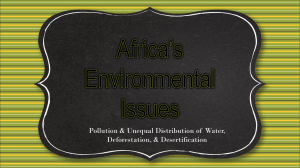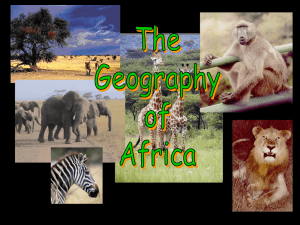Document
advertisement
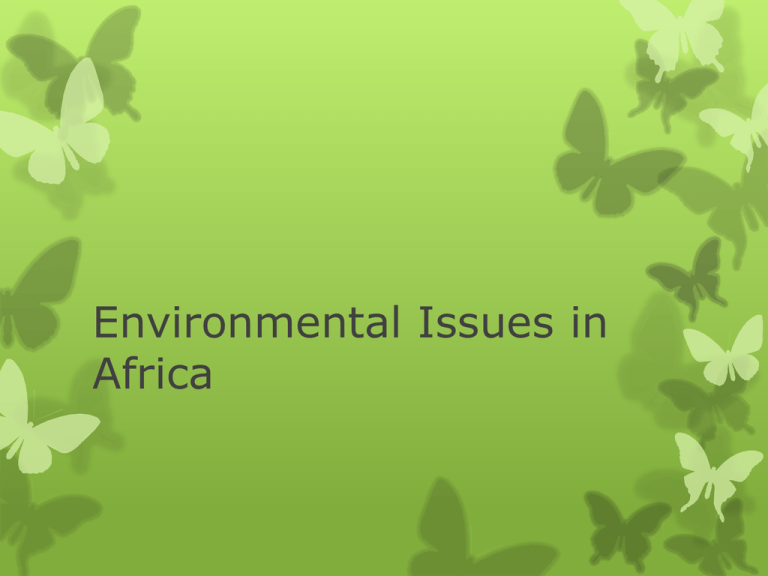
Environmental Issues in Africa The Problems Africans face many different types of environmental issues. Some of them are lack of water, poor soil quality, and expanding deserts. Much of Africa has trouble having enough water for people to live. Parts of Africa are arid desert, others are semi-arid, some are rolling grassland, and still others are humid and sub-tropical. Countries with large river systems have enough water for farming and for people in villages, towns, and cities. People vs. Environment All countries have the problem of increasing pollution from factories, and animal and human waste. Some countries have poor harvests, little grazing land for farm animals, and even little clean water for drinking and washing. Each year deserts claim more and more. The tension between the needs of a growing population and the limited supply of water is a serious issue for most of Africa. Nile River Many countries in Africa do not have enough clean water even though they have large rivers. Egypt is a good example. The Nile River, the longest river in the world, runs the length of Egypt. Most Egyptians live along its banks. The river is used for water and transportation. In recent years, however, overpopulation and poor sanitation regulations have made life along the Nile River more difficult. People are concerned about the water’s contamination with human and industrial wastes. Aswan High Dam The Aswan High Dam has allowed Egypt to have yearround irrigation, so the farmers can grow three crops a year rather than just one. They no longer have to depend on the annual flooding of the Nile to bring water to their fields. The dam is also used to generate electricity for the people of Egypt. Aswan High Dam However, because the Nile no longer floods, the silt (rich topsoil carried by the floodwaters) is no longer deposited in the Egyptian fields. Irrigation requires farmers to use chemical fertilizers instead. Fertilizers are expensive and contribute to the river’s pollution. Fertilizers have caused some parts of Egypt’s farmland to develop heavy concentrations of salt. Land that is contaminated with salt is not suitable for growing crops. Water Clean water is needed for basic health and sanitation. People who are not able to have access to clean water are at risk for many diseases. Lack of clean water to wash with also increases the frequency of skin and eye infections. Some people in Africa also face the problem of waterborne diseases spread by parasites living in standing water. Water Wars! Many who study this region believe that Africa could find itself in the midst of “water wars” in the coming years. The Nile River runs through Ethiopia, Sudan, and Egypt. All of these countries have growing populations and growing water needs. The Niger River supplies the dry Sahel area before flowing into Nigeria. As more water is drawn off upstream, less is available to the countries farther down river. Increases in agriculture also mean greater water needs as well. Factories Some countries in Africa have tried to improve their economies by starting factories. Some have paid little attention to the factory wastes that are flushed into rivers and streams. Government officials ignored environmental problems as long as the factories made profits. Sometimes the factory workers are harmed by the industrial waste that pollutes local water supplies. Sahel The Sahel is an area of Africa south of the Sahara Desert. It is an example of how poor farming practices and the destruction of trees and shrubs can lead to an expanding desert. Most historians believe that the Sahel was once rich farmland. Centuries of farming and grazing along with less rainfall have gradually damaged land in the Sahel. Millions of people struggle to farm in its poor soil. Sahel Deforestation Deforestation is the destruction of trees and other vegetation. This continues to be a problem in the Sahel and elsewhere in Africa. Animals have been allowed to graze too heavily in an area and strip all of the vegetation from the soil. People who need fuel or who hope to be able to clear new farmland cut down the trees that help hold the soil in place. Deforestation Droughts, or periods of little rainfall, have hurt the Sahel, too. The people who live in these areas often face starvation and poverty. Many move into urban areas hoping to find work but most find only more poverty. Deforestation Another place on the continent where rapid deforestation is taking place is in Africa’s west and central tropical rainforests. Many of the rainforests are already gone. Desertification The Sahel is one part of Africa that is experiencing severe problems with desertification, the process of the desert expanding into areas that had formerly been farmland. As the land is overused, the soil becomes poor and powdery. The winds coming from the Sahara gradually blow the dry topsoil away, leaving a barren and rocky land. Periods of drought in recent years have made this situation worse. As the desert expands, people are less able to grow enough food to feed them. Desertification People living in areas going through desertification face hunger and hardship. In the Sahel, however, a majority of the desertification is the result of the actions of people rather than climate. Land is being cleared for farming and trees and shrubs are being cut down for firewood. The survival needs of the people living there are clear, but they are destroying major parts of their environment in the process. Savanna Poaching Illegal hunting of animals is a problem in Africa Many Animals in Africa are endangered People will pay a lot of money for Ivory Tusks and furs. Many reservations for game animals have been set up to protect the animals Kalahari Desert The Kalahari Desert is a desert that covers part of the southern tip of Africa. The people around this desert face the same problems as people in the northern part of the continent. Pressure from increasing populations, the need for fuels like firewood and brush, and the constant grazing of animals have worn away the soil and introduced desertification. Green Line The constant movement of the Sahara Desert can be seen in many of the countries that border that great desert. Some people speak of a “Green Line,” the place where the cultivated land ends and the desert begins. People work hard to try to replant trees, to build windbreaks to keep out the sand, and to push the desert back whenever they can. In many parts of Africa, this has become a losing battle, as the desert claims more land each year. Summary Explain the different environmental problems that are in Africa 1. What is the problem? 2. What are the causes of the problem? 3. What are the effects of the problem? Deforestation Desertification Poaching Clean Water
